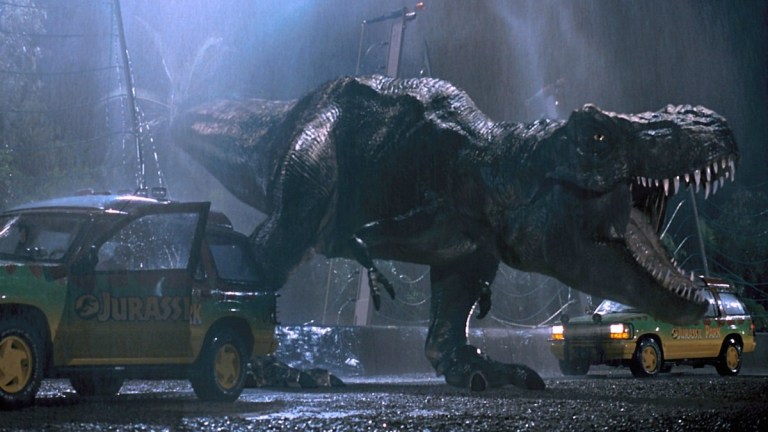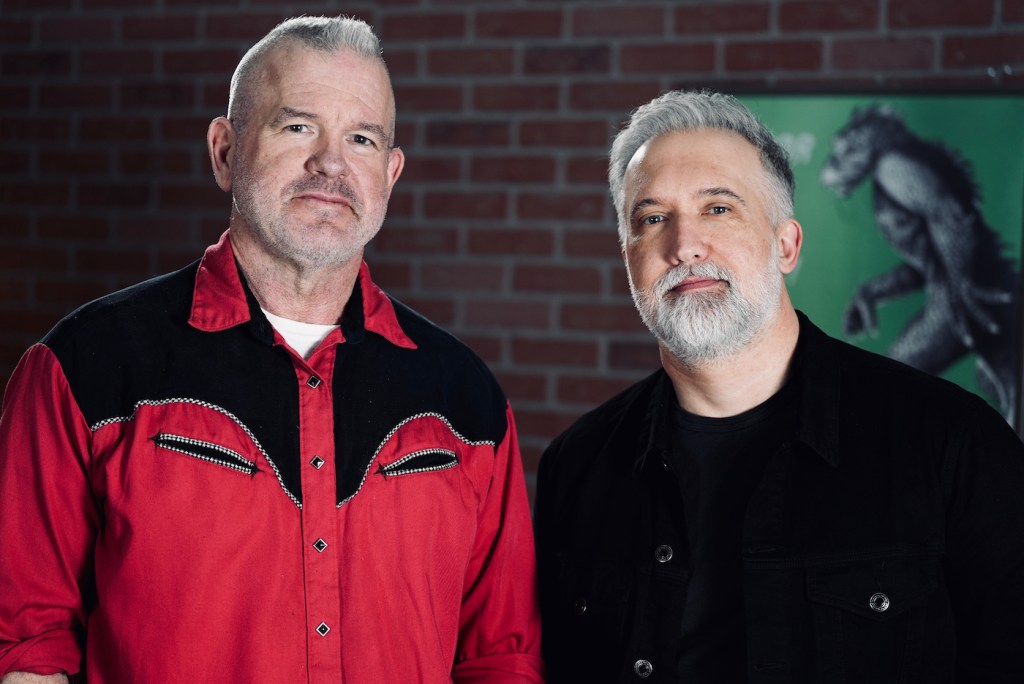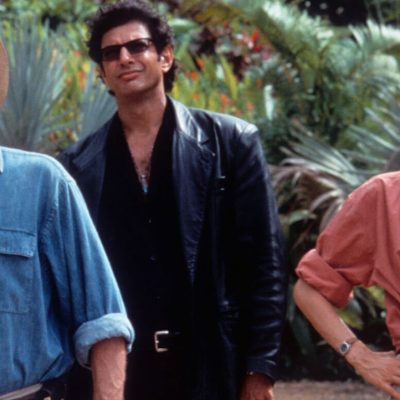The Jurassic Park CGI Rebellion That Began the End of Cinema
Steve “Spaz” Williams helped change moviemaking as we know it with his digital innovations in The Abyss, Terminator 2, and Jurassic Park. And now he has the documentary to prove it.

It was an act of rebellion. That’s how Steve “Spaz” Williams saw it in the early ‘90s, and that’s how he reflects on it even more clearly now. The choice to not-so-subtly sneak the moving image of a computer generated Tyrannosaurus Rex skeleton into Kathleen Kennedy’s line of vision was something he was warned not to do; something that was out-of-bounds since Steven Spielberg’s then developing Jurassic Park was already committed to relying almost exclusively on stop motion animation and animatronics. It was something that never should’ve happened.
And yet, when Kennedy, a producer on Jurassic Park, toured ILM studios alongside Frank Marshall, there it was “in the background” on one of Spaz’s computer screens: a fully digital T. Rex walking with a fluidity hitherto unseen in giant monster movies. The industry would never be the same.
When Williams and filmmaker Scott Leberecht, the latter of whom has just completed the documentary Spaz about his friend’s extraordinary career, enter the Den of Geek studio at SXSW, the digital animator is thoughtful about what an inflection point for the industry this moment was. As Spaz details, Williams already had an incredible career up to that point by becoming one of James Cameron’s point men on the digital effects in The Abyss and Terminator 2: Judgment Day. But this was the moment where his dream of digital organic life was made possible on the big screen—and which in retrospect he welcomes comparisons to it being called his Oppenheimer moment: that point of no return where J. Robert Oppenheimer watched the first successful nuclear bomb test and thought to himself a quote from the Bhagavad Gita: “Now I am become Death, the destroyer of worlds.”
Oppenheimer came to be very critical of the nuclear age he helped usher in, even as he was ushered out the door of the U.S. government. As Williams concedes, his own relationship with George Lucas’ Industrial Light and Magic was not dissimilar.
“I kind of warned about it,” Williams tells Den of Geek while looking back at the fallout from the CGI revolution that occurred in Hollywood after Jurassic Park’s release. “And it’s like Oppenheimer when he got close to the actual thing. He quits and is simultaneously fired. So he basically, tactically, shared that information with other people who could create the balance across the board.”
In that way, Williams accepts he played a significant part in the upheaval of modern cinema.
“What we did sort of [marked] the beginning of the end of moviemaking, because now the antagonists who were the visual effects are becoming the protagonists,” Williams says. “And I sort of said it back then 30 years ago, and everyone got really mad at me, but I think today it’s become fairly obvious what’s happening.”
But for one brief shining moment, he tasted victory by convincing Kennedy at a glance that the future was digital. And Williams’ significant contribution to that paradigm shift is finally getting the wider credit it deserves in Leberecht’s Spaz.
The Life of the ILM Party
When you meet Steve “Spaz” Williams in person, he doesn’t necessarily fit preconceived notions typically associated with technological innovators and computer animators. One suspects Williams might take that as a compliment with his laconic demeanor and concrete handshake. As his documentarian and biographer Leberecht notes, Williams is indisputably erudite and savors discussing the finer points of early ‘90s digital capabilities, particularly in an industry that was still photochemical.
“He was such a contradiction to what the norm was at ILM at that time,” Leberecht says. “It was a lot of highly intellectual, very sophisticated people. And while I’d call him an intellectual… sophisticated? I don’t know.”
Leberecht’s affectionate jape belies that Williams is a proverbial cowboy who in the corporate structure of modern Hollywood might have been surrounded by proverbial city slickers.
At least that is one impression given in the Spaz documentary, which is a film Leberecht has been itching to make for some time. Indeed, before transitioning to directing, Leberecht, too, came up in ILM during the ‘90s, arriving at the fabled VFX house in 1995, two years after Jurassic Park came out and right in the midst of the maelstrom of Hollywood transition: Williams had just finished work on the Jim Carrey comedy, The Mask, and before the decade was out Leberecht would himself be working on digital extravaganzas like Flubber and Sleepy Hollow.
In ’95 though, Leberecht was still only an intern at the age of 24, when Spaz walked into the room.
“I picked him out,” Williams recalls now. “I was working and I saw him drawing stuff and I said, ‘That guy’s coming with me.’”
They’d be buddies in the decades to come, with Leberecht (unlike some at ILM) enjoying Williams’ occasionally mercurial disposition.
“His reputation definitely preceded him,” Leberecht says now. “Everyone knew if Steve was going to be in a meeting it was going to be crazy and would probably spin off into other directions before anyone got down to business. But that was the fun about him. It was always like a party whenever he was in the room.”
That party also came with an acute understanding of the direction his industry was headed in—and how to be at the forefront of it.
Climbing Out of The Abyss
When Williams came to ILM in 1988, it was, as one colleague surmised, a chance for him to work somewhere that would “subsidize his insanity.”
Says Williams, “I had been part of a bunch of studios, including military places where they did have an impressive amount of money, but it wasn’t dedicated to the entertainment side or necessarily exploration. So ILM was sort of the first place that when I joined it, I couldn’t believe you could do multiple takes of things. They seemed to have the backing, and there were some managers in upper management like Scott Ross who did have the attitude to say, ‘Let’s give this a shot.’”
Yet the ILM of the late ‘80s was a far different place than it is today, or even where it’d be when Williams surprised Kennedy with a T. Rex skeleton. At the time, there was still some skepticism, at least in the short-term, about the viability of digital effects. Just two years before Williams got to ILM, the visual effects company’s owner, George Lucas, had just sold off his own Lucasfilm’s computer division, Graphics Group. That division went on to become Pixar Animation Studios. So ILM was feeling the pressure by ’88.
“There were only five of us in that department,” Williams remembers. “There were a few of us that were pushing to do organic animation; it was a new frontier [but it] pitted you with personal challenges, because if you don’t solve it, there’s going to be a problem. George Lucas was not going to throw more money into that department, so we really had to prove it.”
The proof of purpose arrived in dividends with the release of The Abyss in 1989, James Cameron’s aquatic fantasy about strange beings who live deep beneath the sea. Indeed, Williams alongside Mark Dippé, another maverick visual effects animator at ILM, were chiefly responsible for the success of The Abyss’ most revolutionary sequence: where a digital face of water representing a sentient, and almost godlike, intelligence manifests itself aboard Mary Elizabeth Mastrantonio’s submarine. The sequence was so cutting edge that Cameron threatened Dippé and Williams with the prospect of it being cut from the film if it didn’t work.
Looking back now, Williams considers it his favorite among all the sequences he ever worked on.
“It was 18 shots and 72 seconds, and took about six months to animate,” he says, “and there’s something of a gentle personality in that, that I really like.”
It so impressed Cameron, too, that he essentially promoted Williams and Dippé to be his CG maestros in creating another digital character who would not be cut from the film if he didn’t work: the T-1000 in Terminator 2.

Banned from Skywalker Ranch
The Spaz documentary excavates rich anecdotes and amusing detours from the early Wild West days of digital effects moviemaking. And in that wild, there was hardly a more colorful character at the saloon than Williams, who had made a habit of playing “Stairway to Heaven” and other “calming” rock anthems on bagpipes to his machines each night. “There was a lot of stress,” Williams explains now, noting that he thought it could ease the machines from dumping digital frames overnight, which threatened to ruin any shot.
However, that seemingly self-cultivated bad boy image developed by Williams and Dippé threatened to overwhelm their careers, and did eventually do exactly that in Williams’ case. Hence one of the most illuminating episodes in the documentary where Leberecht reveals how close Williams and Dippé came to being fired by Lucas because of an ill-fated visit to Skywalker Ranch.
“That was February in 1991,” Williams says with a faint smile when we bring up the incident. “And we got invited up to the ranch for dinner… so we’re up there, and George Lucas wasn’t there, he was in England at the time. So then three of us are walking around in the main house, and we knew not to go to the second floor, but we did anyway. And unbeknownst to us, they had a pressure sensitive carpet in what we thought was a library but was George Lucas’ office.” He then adds with a slightly larger smile that maybe they did, kind of, know who’s office it was.
So there they were, ILM’s “rebels” sitting on Lucas’ desk, smoking his cigars, and carrying their own drinks into the room. When security inevitably burst into this scene, the animators thought it was a harmless situation and gave the names of other ILM employees, including one of Williams’ own managers, Scott Ross. Yet the next day at work, it turned out not to be something to laugh off.
“So the next day the call came in, and Scott said what the hell did you guys do?” Williams remembers. “[I said], ‘Nothing, we were messing around.’ He says, ‘Well, they want you fired!’”
In fact, the order came from so high up that the only reason they weren’t was because of Cameron, who with tight deadlines on T2 had little time or interest in dealing with bruised egos.
“We found out years later that James Cameron got the call that Lucas wants these guys fired, and Cameron told us that he said ‘if you fire Steve Williams and Mark Dippé, I will yank Terminator from ILM.’”
So instead of being fired, Williams and Dippé were permanently banned from Skywalker Ranch. Williams also notes he never received a Christmas bonus again from ILM. It was perhaps a turning point in rising tension which escalated over the years, even as Williams orchestrated what was arguably ILM’s most revolutionary moment less than a year later.
The Jurassic Ambush
One of the most remarkable elements of the Spaz documentary is how sharply it highlights many of the luminaries of the special effects world who were there during a moment of upheaval throughout the industry. Many ILM alumni like Dippé speak to Leberecht about their memories of those heady days. And of Spaz.
“The people that I personally wanted to talk to were the people I knew were there from the earliest days in the evolution of all that innovation,” Leberecht says. “So they were people that I don’t feel like I’ve seen a lot of interviews with from that time, and yet I know they were right there when it happened because I worked with them. So reaching out to them and asking them to talk about what happened during that time… they were very much waiting to tell the story of what they witnessed and experienced.”
Perhaps most remarkably though is the inclusion of Phil Tippett, the special effects maestro who produced the peerless stop-animation effects in The Empire Strikes Back, Indiana Jones and the Temple of Doom, and RoboCop. He also was the man whose profession, much like Dr. Alan Grant, would face an existential threat when Spielberg opted at the last minute to pursue digital effects on Jurassic Park instead of Tippett’s previously agreed upon stop motion.
Tippett’s inclusion in the doc where he talks about this moment of transition is also striking since he seems open and good-natured about what happened in those days—even while Jurassic Park’s visual effects supervisor Dennis Muren does not appear to give a modern interview about his memories.
“I talked to him quite a lot for several years,” Leberecht says, “but it never really worked out. I wanted him in the film very badly, I wanted that very much.”
That desire for his perspective is understandable. Perhaps more than any single visual effects talent of that era, Muren became the face of ILM during the glory days of the early 1990s; the one who got to make the speeches when ILM won Oscars for Best Visual Effects on The Abyss, T2, and Jurassic Park; and the man whose speeches the documentary sharply demonstrates never mentioned Williams, even on Jurassic Park, despite Spaz being the one to essentially force Muren into using CGI on the dinosaurs.
That rising tension is palpable in the documentary since it contextualizes what would eventually lead to Williams’ exit from ILM.
“This was just a scenario where there was outrage for a while,” Williams says, “but it sort of extended from Terminator, which extended from The Abyss, and it got worse each time.”
In many ways, it came to a head when Muren, who according to the doc had a ceiling of knowledge when it came to implementing digital effects, told Williams to sit down when the latter said they could build all the dinosaurs in Jurassic Park with computers.
“Dennis had heard a rumor [about the CGI skeleton] and he told me, literally, he said don’t bother doing this, it’s impossible,” Williams recalls. “I didn’t listen because I just didn’t believe it wouldn’t happen; it was inevitable whether I did it or someone else did.”
Hence the fateful act of rebellion. Or as Williams describes it, “I was forced to ambush Kathleen Kennedy and Frank Marshall.”
When she saw the walking skeleton on one of Williams’ monitors, Kennedy made a beeline straight for the computer and told Williams he had a bright future. Spaz is aware of the irony of that statement.
According to Williams, he wasn’t reprimanded at the time. How could he be when the digital effects would become the innovation that made Jurassic Park such a landmark film? He tells us he only received “the evil eye” because of his defiance of authority. Nevertheless, when the story of those times were told in mass media, until very recently Williams’ name was left out of the canon. When you watch the making of documentaries on a Jurassic Park DVD, it is Dennis Muren who Spielberg credits with coming up to him and enthusiastically suggesting the director consider CGI dinosaurs instead of stop motion for the wide shots. And when Oscar night rolled around, during the last Oscar speech Muren would give, he thanked Tippett, who after seeing his stop motion go extinct got a cursory credit as “dinosaur supervisor.” But not Williams.
“Well, there’s a ministry of propaganda that spins stories, and that’s fine,” Williams says about how the official Jurassic Park story has been largely told until Spaz and a recent Netflix episode of The Movies That Made Us. “It’s a tale as old as time, and our industry is not the only one that suffers from this kind of thing. It’s like Nikola Tesla prior to Edison with alternating current versus direct current.”
The Destroyer of (Practical) Worlds
Sitting in the Den of Geek studio today, Williams seems at peace with how it all played out, including his eventual exit from ILM that grew more contentious after he called many of the folks who worked there “pencil necks” in the press. He tried to run his own visual effects animation house for a time, as well as directing, and he’s had a ringside seat to see how many of the predictions he made about the future of visual effects in the early ‘90s have come to pass, even as he considers his role in it now as helping hasten “the beginning of the end of moviemaking.”
“It’s like you draw blood right away when you have 2800 to 3000 [composite] shots,” Williams says of what he views as the overuse of visual effects in modern Hollywood tentpoles. “Jurassic was only 50 shots. If you look at something like what Ridley Scott did on Alien, which is photochemical [as opposed to digital photography], he showed you bits of the creature so your brain, the most powerful weapon you have, is filling in the blanks. One of our things was showing the money shots [that only lasted] five, six second shots with a dinosaur in full-frame. All of a sudden you desensitize audiences, so you have to somehow up it.”
He continues, “So now you’re in this frenetic franchise like Jurassic where they go, ‘We found a bigger creature that we didn’t know existed, but it’s even bigger than a Rex!’ Oh great, run the trailers. That’s the problem with it.”
One of the other developments Williams predicted in the ‘90s was that there would come a day when deceased actors would be brought back from the dead via digital recreations. At the time it was considered a tasteless and unlikely observation, but in a world where we now have flashbacks of Carrie Fisher’s younger Princess Leia in Star Wars: The Rise of Skywalker or Harold Ramis getting an extended curtain call years after his death in Ghostbusters: Afterlife, it’s increasingly becoming just another staple of modern tentpole filmmaking.
“I warned against that 40 years ago,” says Williams. “It was inevitable to have the resurrection of deceased actors, which I didn’t necessarily think was a good thing. Also heads of state giving speeches they never gave [will become a norm]. Pixels have no conscience and they’re also addressable.”
That might be so, but with Spaz, Leberecht and Williams address a significant moment in moviemaking’s recent past, and tell some of the stories that once seemed almost digitally erased.
Spaz premiered at SXSW on March 14 and is currently looking for distribution.


